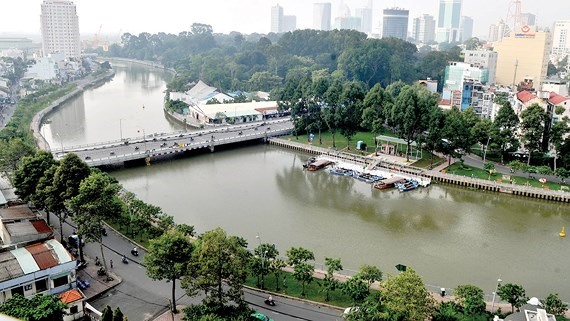 Environment
Environment

The People’s Committee of HCM City has asked the Department of Natural Resources and Environment to work with local agencies to strictly monitor the discarding of litter and raw sewage in the Nhiêu Lộc – Thị Nghè Canal.
 |
| HCM City authorities are ensuring strict monitoring of water quality of the Nhiêu Lộc – Thị Nghè Canal, which traverses five city districts. – Photo sggp.org.vn |
HCM CITY — The People’s Committee of HCM City has asked the Department of Natural Resources and Environment to work with local agencies to strictly monitor the discarding of litter and raw sewage in the Nhiêu Lộc – Thị Nghè Canal.
The departments of Agriculture and Rural Development and Transport as well as the HCM City Steering Centre for Urban Flood Control in districts 1, 3, Bình Thạnh, Phú Nhuận and Tân Bình have been tasked to prevent further incidents like the alarming amount of dead fish found in the canal at the beginning of the rainy season.
The Department of Natural Resources and Environment will work with local authorities of districts where the canal is located to encourage citizens not to throw litter or sewage into the canal.
Factories and industrial parks that discharge over 1,000 cubic metres of wastewater a day must set up automatic measuring stations that directly link to the Department of Natural Resources and Environment, according to the People’s Committee.
To reduce the amount of toxins in the canal, the city will increase sewage pumping to at least 64,000 cubic metres per hour after heavy rains.
The flood-tide control sewers on the canal will also be monitored closely to regulate water levels in the rainy season and protect water quality.
The authorities also plan to continue strictly monitoring and regulating all wastewater treatment systems in industrial parks, export processing zones, high-tech parks and industrial clusters, and will set up automatic wastewater measurement stations directly linked to the Department of Natural Resources and Environment.
By 2020, the city targets collection and treatment of all industrial and medical liquid wastes and 90 per cent of industrial fumes.
It also plans to reduce surface water pollution by 90 per cent and air pollution by 70 per cent in comparison with 2011.
District authorities need to encourage citizens not to directly litter into the canal or pick up dead fish for consumption.
The task of checking sewage coming from manufacturing facilities must be strengthened to ensure that sewage is properly processed before being released into the environment.
The Nhiêu Lộc-Thị Nghè Canal snakes through District 1, District 3, Phú Nhuận, Bình Thạnh, and Tân Bình districts with more than 1.2 million residents living along the canal.
Once heavily polluted and dubbed a "dead canal" back in the 1950s, it was revitalised following an expensive clean-up project, the first phase of which ended in 2012.
The city’s Department of Transport completed phase I of the HCM City Environmental Sanitation Project with a US$200 million thanks to the World Bank’s financial assistance from 2001 to 2010.
Phase II with US$450million financed by the Word Bank involves the construction of a Wastewater Treatment Plant (WWTP), an interceptor under the canal, and reinforcement for the banks of the canal.
The canal is now considered to be one of the most beautiful canals in the city and has even become a tourist attraction. — VNS